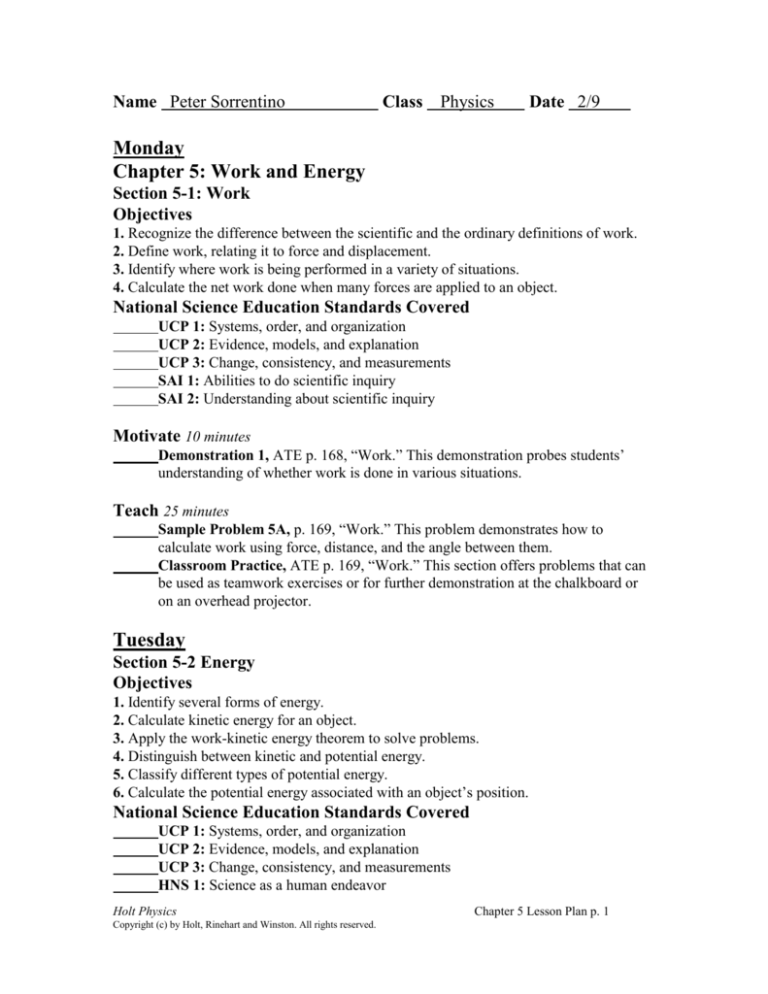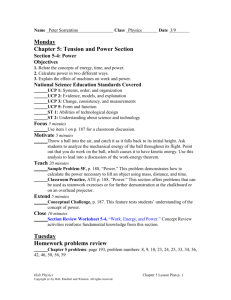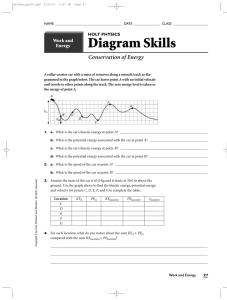
Name Peter Sorrentino
Class
Physics
Date 2/9
Monday
Chapter 5: Work and Energy
Section 5-1: Work
Objectives
1. Recognize the difference between the scientific and the ordinary definitions of work.
2. Define work, relating it to force and displacement.
3. Identify where work is being performed in a variety of situations.
4. Calculate the net work done when many forces are applied to an object.
National Science Education Standards Covered
UCP 1: Systems, order, and organization
UCP 2: Evidence, models, and explanation
UCP 3: Change, consistency, and measurements
SAI 1: Abilities to do scientific inquiry
SAI 2: Understanding about scientific inquiry
Motivate 10 minutes
Demonstration 1, ATE p. 168, “Work.” This demonstration probes students’
understanding of whether work is done in various situations.
Teach 25 minutes
Sample Problem 5A, p. 169, “Work.” This problem demonstrates how to
calculate work using force, distance, and the angle between them.
Classroom Practice, ATE p. 169, “Work.” This section offers problems that can
be used as teamwork exercises or for further demonstration at the chalkboard or
on an overhead projector.
Tuesday
Section 5-2 Energy
Objectives
1. Identify several forms of energy.
2. Calculate kinetic energy for an object.
3. Apply the work-kinetic energy theorem to solve problems.
4. Distinguish between kinetic and potential energy.
5. Classify different types of potential energy.
6. Calculate the potential energy associated with an object’s position.
National Science Education Standards Covered
UCP 1: Systems, order, and organization
UCP 2: Evidence, models, and explanation
UCP 3: Change, consistency, and measurements
HNS 1: Science as a human endeavor
Holt Physics
Copyright (c) by Holt, Rinehart and Winston. All rights reserved.
Chapter 5 Lesson Plan p. 1
HNS 3: History of science
PS 5b: All energy can be considered to be either kinetic energy, which is the
energy of motion; potential energy, which depends on relative position; or energy
contained by a field, such as electromagnetic waves.
Focus 5 minutes
Write the definition of kinetic energy on the chalkboard or on an overhead
projector. Below the definition, write the following question: “Which of the
following has kinetic energy? 1. a falling sky diver 2. a parked car 3. a shark
chasing a fish 4. a calculator sitting on a desk” [1 and 3 are examples of kinetic
energy.]
Motivate 5 minutes
Ask students to answer the following question in reference to Figure 5-4. “If the
bowling ball and volleyball are traveling at the same speed, do they have the same
kinetic energy?” [No, the bowling ball has a greater mass and therefore has more
kinetic energy.]
Teach 35 minutes
Misconception Alert, ATE p. 172. This feature stresses that kinetic energy does
not depend on the direction of motion.
Sample Problem 5B, p. 173, “Kinetic energy.” This problem demonstrates how
to calculate kinetic energy using mass and speed and how to calculate speed using
mass and kinetic energy.
Classroom Practice, ATE p. 173, “Kinetic energy.” This section offers problems
that can be used as teamwork exercises or for further demonstration at the
chalkboard or on an overhead projector.
Sample Problem 5C, pp. 175–176, “Work–kinetic energy theorem.” This
problem demonstrates how to solve problems using the work–kinetic energy
theorem.
Wednesday continuation of section 5.2 Energy
Teach 20 minutes
Demonstration 3, ATE p. 175, “Potential energy.” This demonstration shows that
potential energy is stored energy.
Visual Strategy, ATE p. 175. This feature points out that the spring’s potential
energy in Figure 5-8 depends on the distance the spring is compressed.
Sample Problem 5D, p. 179, “Potential energy.” This problem demonstrates how
to calculate the total potential energy of a mass on a spring using the object’s mass
and height, the spring constant, and the distance compressed.
Classroom Practice, ATE p. 179, “Potential energy.” This section offers
problems that can be used as teamwork exercises or for further demonstration at
the chalkboard or on an overhead projector.
Extend 15 minutes
Physics on the Edge, PE pp. 190–191, “The Equivalence of Mass and Energy.”
This feature delves further into Einstein’s special theory of relativity by describing
the concept of the equivalence of mass and energy.
Holt Physics
Copyright (c) by Holt, Rinehart and Winston. All rights reserved.
Chapter 5 Lesson Plan p. 2
Close 10 minutes
Section Review 5-2, “Energy.” Diagram Skills activities bridge the gap between a
real, physical situation and the diagram that simplifies it so that key physics
principles and equations can be applied.
Thursday
Section 5-3: Conservation of energy
Objectives
1. Identify situations in which conservation of mechanical energy is valid.
2. Recognize the forms that conserved energy can take.
3. Solve problems using conservation of mechanical energy.
National Science Education Standards Covered
UCP 1: Systems, order, and organization
UCP 2: Evidence, models, and explanation
UCP 3: Change, consistency, and measurements
SAI 1: Abilities to do scientific inquiry
SAI 2: Understanding about scientific inquiry
Focus 5 minutes
Assign item 27 on p. 195.
Motivate 5 minutes
Demonstration 4, ATE p. 181, “Mechanical energy.” This demonstration shows
two kinds of energy in a mechanical system.
Teach 25 minutes
Demonstration 5, ATE p. 182, “Conservation of energy.” This demonstration
shows the conservation of mechanical energy.
Sample Problem 5E, pp. 184–185, “Conservation of mechanical energy.” This
problem demonstrates how to solve problems involving the conservation of
mechanical energy.
Classroom Practice, ATE p. 184, “Conservation of mechanical energy.” This
section offers problems that can be used as teamwork exercises or for further
demonstration at the chalkboard or on an overhead projector.
Misconception Alert, ATE p. 186. This feature distinguishes between the
conservation of mechanical energy and the general energy conservation law.
Close 10 minutes
Section Review Worksheet 5-3, “Conservation of Energy.” Diagram Skills
activities bridge the gap between a real, physical situation and the diagram that
simplifies it so that key physics principles and equations can be applied.
Friday
Lab 45 minutes
Laboratory Exercise, pp. 200–205, “Conservation of Mechanical Energy.”
Students determine the spring constant of a spring, calculate elastic potential
energy, calculate gravitational potential energy, and determine whether
mechanical energy is conserved in an oscillating spring.
Holt Physics
Copyright (c) by Holt, Rinehart and Winston. All rights reserved.
Chapter 5 Lesson Plan p. 3






